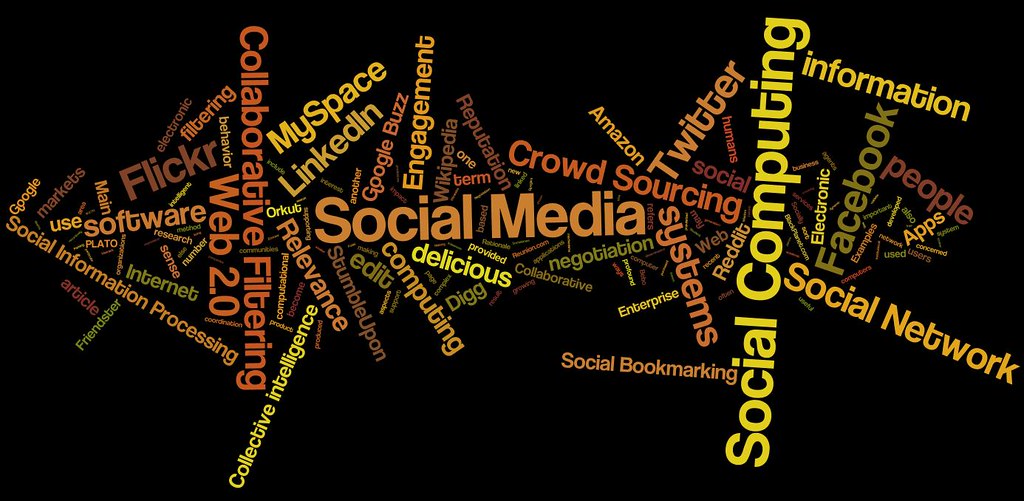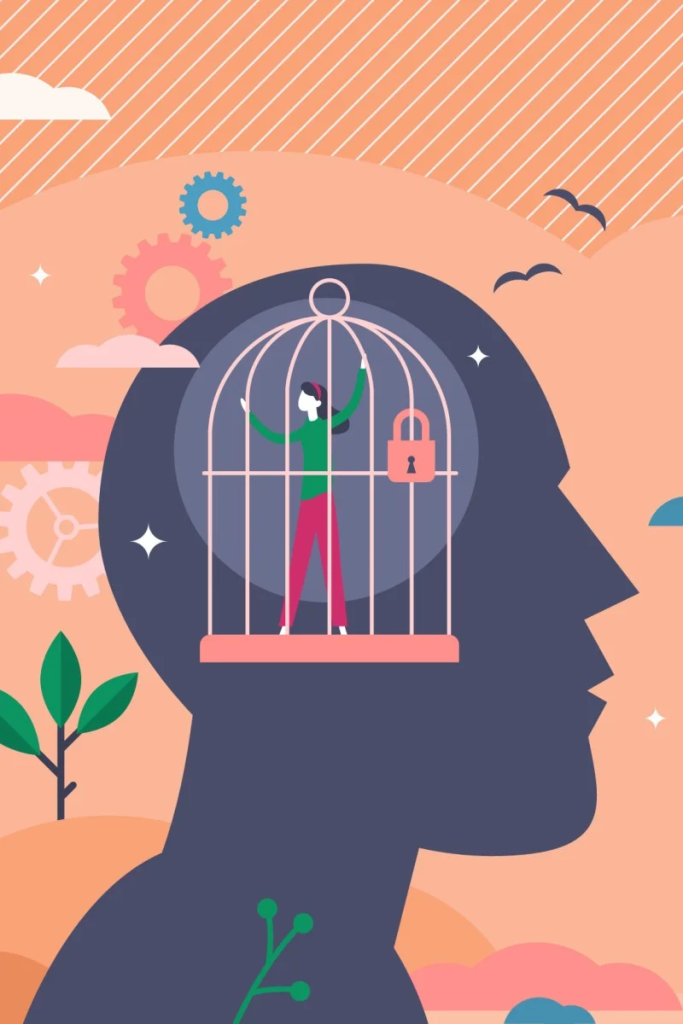Keywords: Information Cocoon, Echo Chamber, Lack of Information Diversity, Social Media, Application, Information Filtering Bubbles, Algorithmic Recommendation, Governments, Commercial Network, TikTok, Covid-19, Fake news, Societal Divisions.

“social media, social networking, social computing tag cloud (#3)” by daniel_iversen is licensed under CC BY 2.0.
Unveiling the Information Cocoon
As science and technology continue to advance, the avenues and diversity of information sources available to citizens are expanding. Despite the increased array of information choices, individuals continue to experience a lack of diversity in the information they receive. As citizens frequently lean towards selectively concentrating on information aligned with their interests or beliefs, while disregarding or evading information that challenges their viewpoints.
This phenomenon is termed the ‘information cocoon,’ also known as the “echo chamber”, proposed by Sunstein (2006, p9), wherein individuals state into a ‘safe zone,’ neglecting the diversity and intricacies of the external world, akin to the concept of being cocooned within a cocoon.
The Genesis of Information Cocoons: Understanding Their Formation
The emergence of information cocoons can be attributed to individual preferences and algorithmic interactions. To be more specific, social platforms use recommendation algorithms to analyze an individual’s online behavior. Furthermore, social media platforms expertly learn an individual’s preferences and subtly direct them to choose from a range of alternatives, thereby uncovering their innermost desires. (Ma et al., 2022, p4)

“TikTok” by Solen Feyissa is licensed under CC BY-SA 2.0.
For instance, platforms such as TikTok utilize recommendation algorithms to anticipate individual interests and preferences by analyzing user interactions such as clicks, likes, viewing duration, comments, shares, and searches. Subsequently, they curate content tailored to these interests and preferences, effectively guiding users toward videos that match their specific interests. (Smith, 2021) TikTok’s algorithm is also able to identify when a user is tired of a particular type of video, prompting it to suggest new video types to align the content exposure with user expectations. (Smith, 2021)
Moreover, these applications use “information filtering bubbles” when making content recommendations. This approach involves filtering out views and information sources that do not align with users’ interests, thus making it challenging for individuals to access information and perspectives beyond their immediate circle. This process intensifies the formation of information cocoons, therefore, individual choices and algorithms are two key factors that contribute to the formation of information cocoons.
Read More: How TikTok Reads Your Mind
Weighing the Benefits and Drawbacks of Information Cocoons
- The Advantages of the Information Cocoon
Echo chambers facilitate easier access to desired information for individuals. (Stories From Experts About the Impact of Digital Life, 2022) Also, enables businesses to understand user preferences legally, enhancing their ability to effectively market products and stimulate economic growth. (Author,2021) However, the presence of information cocoons also raises significant concerns about their impact on our lives.
Read More:
Algorithmic Search and Recommendation Systems: The Brightside, the Darkside, and Regulatory Answers
- The disadvantages of the information Cocoon
- Individual
The information cocoon effect diminishes information diversity and leads individuals into a state of information closure, posing significant risks to both individuals and society.
Firstly, information cocoons pose a serious threat to an individual’s social circle and mind. Algorithmic recommendations filter the content users encounter, reducing exposure to diverse perspectives and information from various sources. This narrowing of the “circle of safety” will limit citizen’s social circle and their chances to gain insights into the broader world. (He et al., 2023)
In other words, information cocoons keep people trapped in their own thoughts, undermining information diversity. Simultaneously, the restricted information individuals receive significantly impacts their critical thinking abilities, fostering cognitive inflexibility.
In addition, prolonged exposure to an information cocoon’s informational confinement can result in individuals becoming increasingly isolated from the external world, potentially adversely affecting their mental health.
As an example, Yiqing He and colleagues (2023) discovered that information cocoons exacerbated feelings of loneliness and depression among elderly individuals. Due to their limited experience with circumventing recommendation algorithms, older people face challenges in accessing a wide range of information, restricting their ability to explore life’s opportunities. These information cocoons isolate older adults from society, and the dearth of information can contribute to heightened emotional loneliness and mental health issues.
- Society
The information cocoon effect encourages the proliferation of misinformation, exacerbates the impact of social events, and contributes to social polarization. By constraining an individual’s exposure to diverse information sources, the information cocoon renders individuals more susceptible to the influence of particular pieces of information.
Within information cocoons, individuals frequently engage with like-minded individuals, facilitating the rapid dissemination of disinformation since it tends to align with the group’s established beliefs and stances.
In closed information ecosystems, where individuals are more susceptible to extreme viewpoints and emotional manipulation, the continuous recommendation of content that aligns with their existing views by social media platforms can exacerbate polarization. This intensification can give rise to increasingly emotional group dynamics.
As a result, individuals are exposed to misleading or false information that reinforces their preconceived ideas, potentially resulting in significant real-world consequences.

“A hospital corpsman prepares a COVID-19 vaccine.” by Official U.S. Navy Imagery is licensed under CC BY 2.0.
For instance, instances of misleading information in the media regarding COVID-19 vaccines, like unfounded allegations linking vaccines to autism, have prompted individuals to reject vaccination, consequently worsening the epidemic’s transmission. (Skafle et al., 2022)

Simultaneously, during the COVID-19 pandemic, the media published disparaging statements and false statements about Asians without fact-checking, raising the issue of discrimination against Asians in society. This discrimination has even led some Asians to suffer verbal and physical attacks in their daily lives. (Tavernise & Oppel, 2021)
Individuals within information cocoons are susceptible to the rapid dissemination of disinformation on social media. Furthermore, emotional manipulation has a higher likelihood of inciting societal incidents in such environments because people are prone to collective action in alignment with their beliefs, and they have limited exposure to differing perspectives. This dynamic can ultimately result in societal divisions.
Read More:Covid-19 Fueling Anti-Asian Racism and Xenophobia Worldwide
Break the Information Cocoon Trap
In the contemporary digital era, completely avoiding the information cocoon has become exceedingly challenging, as users find themselves confined to a narrow stream of information, limiting their exposure to a range of perspectives. Information cocooning has evolved into a pervasive challenge that necessitates these key areas of action to alleviate its adverse effects and foster diversity in information and critical thinking.

https://www.chaptersfrommylife.com/2010/03/trapped-in-cocoon.html
- Proactive Engagement from Individuals.
- Collaboration Between Governments and Businesses.
Firstly, citizens often unconsciously create information cocoons when selecting information, making it essential to actively cultivate critical thinking as one of the effective ways to break free from these cocoons. Specifically, when individuals encounter information, they should avoid blindly trusting a single information source and instead actively seek out diverse sources of information, including those that encompass different perspectives and viewpoints. (Peng & Liu, 2021) Secondly, periodically reflecting on and examining one’s information consumption habits ensures that one does not fall into the trap of exclusively consuming information that aligns with their own views. Additionally, active participation in various social circles, and engaging with people from diverse backgrounds and beliefs, helps broaden one’s cognitive horizons, facilitating a better understanding of different viewpoints and perspectives.

Secondly, governments hold a crucial role in supporting journalism education, promoting information literacy training, and implementing effective regulation to encourage diverse information dissemination across media and digital platforms. For example, some people distrusted vaccines due to false information and chose not to vaccinate. When the government was dealing with the COVID-19 vaccine information cocoon, they used multiple channels of communication, including social media, radio, television, and the Internet, to communicate accurate information about COVID-19 vaccines. They have launched extensive information campaigns and made data transparent to help the public better understand the safety and effectiveness of vaccines. (“Enhancing Public Trust in COVID-19 Vaccination: The Role of Governments,” 2021)

“Kenya COVID-19 Vaccine Health Worker Training” by USAID_IMAGES is licensed under CC BY-NC 2.0.
Lastly, companies should embrace transparent algorithmic recommendation strategies that encourage users to encounter a wide array of viewpoints, while ensuring their content doesn’t contribute to polarization or division. These comprehensive efforts can assist in mitigating the detrimental impact of information cocoons on society and facilitating a more extensive range of information and an enhanced understanding of multiple perspectives.
References:
Author, G. (2021). Algorithmic search and recommendation systems: the brightside, the darkside, and regulatory answers. Competition Forum. https://competition-forum.com/algorithmic-search-and-recommendation-systems-the-brightside-the-darkside-and-regulatory-answers/
Enhancing public trust in COVID-19 vaccination: The role of governments. (2021). In OECD Policy Responses to Coronavirus (Covid-19). https://doi.org/10.1787/eae0ec5a-en
He, Y., Liu, D., Guo, R., & Guo, S. (2023). Information cocoons on short video platforms and its influence on depression among the elderly: a moderated mediation model. Psychology Research and Behavior Management, Volume 16, 2469–2480. https://doi.org/10.2147/prbm.s415832
Ma, X., Sun, Y., Guo, X., Lai, K., & Vogel, D. (2022). Understanding users’ negative responses to recommendation algorithms in short-video platforms: a perspective based on the Stressor-Strain-Outcome (SSO) framework. Electronic Markets, 32(1), 41-58. https://doi.org/10.1007/s12525-021-00488-x
Peng, H., & Liu, C. (2021). Breaking the information cocoon: When do people actively seek conflicting information? Proceedings of the Association for Information Science and Technology, 58(1), 801–803. https://doi.org/10.1002/pra2.567
Skafle, I., Nordahl‐Hansen, A., Quintana, D., Wynn, R., & Gabarrón, E. (2022). Misinformation about COVID-19 vaccines on social media: Rapid review. Journal of Medical Internet Research, 24(8), e37367. https://doi.org/10.2196/37367
Smith, B. (2021, December 6). How TikTok reads your mind. The New York Times. https://www.nytimes.com/2021/12/05/business/media/tiktok-algorithm.html
Stories from experts about the impact of digital life. (2022, September 15). Pew Research Center: Internet, Science & Tech. https://www.pewresearch.org/internet/2018/07/03/the-positives-of-digital-life/
Sunstein, C. R. (2006). Dream and Night. In C. Sunstein (Ed.), Infotopia : how many minds produce knowledge. Oxford University Press.
Tavernise, S., & Oppel, R. A., Jr. (2021, May 6). Spit On, Yelled At, Attacked: Chinese-Americans Fear for Their Safety. The New York Times. https://www.nytimes.com/2020/03/23/us/chinese-coronavirus-racist-attacks.html
- Friday 10am (Hamideh)
- Friday 10am (Punit)
- Friday 11am (Billie)
- Friday 12pm (Punit)
- Friday 1pm (Jenni)
- Friday 2pm (Punit)
- Friday 3pm (Jenni)
- Friday 9am (Billie)
- Mon 10am (Wenjia)
- Mon 14pm (Wenjia)
- Monday 11am (Nipa)
- Monday 9am (Nipa)
- Thursday 10am (Mahsa)
- Thursday 11am (Punit)
- Thursday 12pm (Mahsa)
- Thursday 1pm (Xuanzi)
- Thursday 9am (Punit)
- Uncategorized
- Wednesday 11am (Hamideh)
- Wednesday 12pm (James)
- Wednesday 12pm (Xuanzi)
- Wednesday 1pm (Hamideh)
- Wednesday 3pm (James)
- Wednesday 4pm (Hamideh)
- Wednesday 8am (Hamideh)
- Wednesday 9am (James)
- April 2025
- March 2025
- February 2025
- January 2025
- December 2024
- November 2024
- October 2024
- September 2024
- August 2024
- July 2024
- June 2024
- May 2024
- April 2024
- March 2024
- February 2024
- January 2024
- December 2023
- November 2023
- October 2023
- September 2023
- August 2023
- July 2023
- June 2023
- May 2023
- April 2023
- March 2023
- November 2022
- May 2022

Leave a Reply
You must be logged in to post a comment.